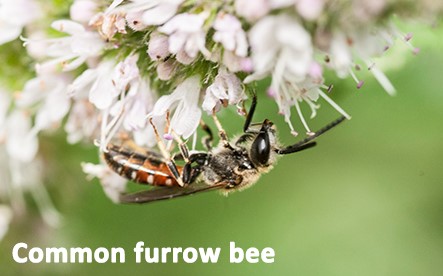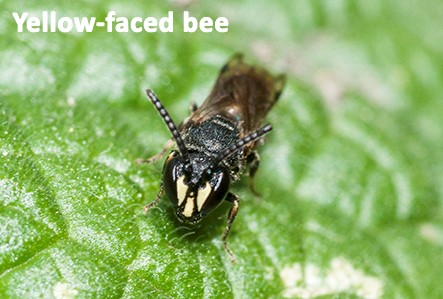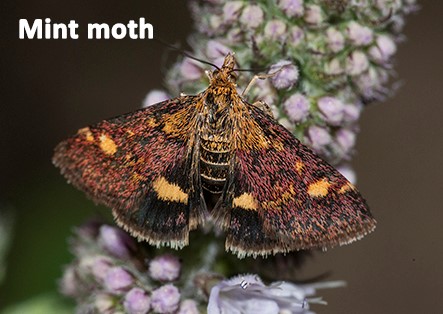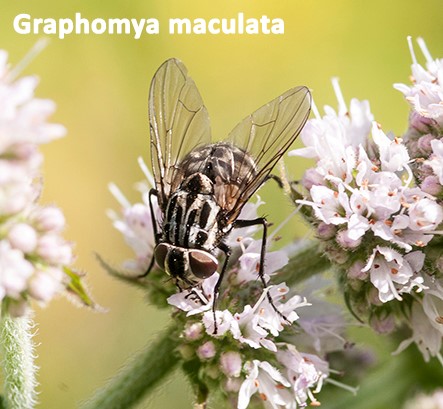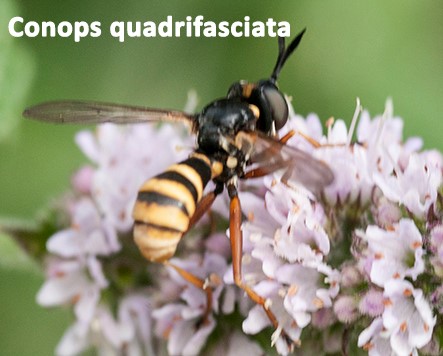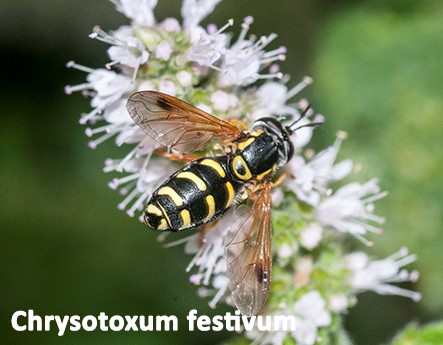This article has been written by our expert on biodiversity Dr Martin Angel and is well worth sharing with others through our website. Further articles are planned.
To illustrate this I have prepared this photo-essay of some of the insects that have been visiting the flowers of our garden mint over the past few of weeks – and it only includes those species I feel confident enough to name.

Most people consider honey bees as being the prime pollinators, and indeed they are important. However, there are many other important pollinators.

There have been at least three species of bumblebee – the buff -tailed bumblebees (Bombus terrestris) has been the most common.

There have been several types of solitary bee – for example
Davies Colletes (Colletes daviesanus) is only a little smaller than a honey bee. It has yellow hairs on its back legs, but the yellow becomes greatly extended because it collects copious quantities of pollen that it sticks to its thorax and hind legs.
Smaller and slimmer bees have been common furrow bees (Lasioglossum calceatum), and smaller still have been common yellow-faced bees (Hylaeus communis). These tiny bees are only about 5mm long. They are identified by their facial patterns, so I am showing a picture of one head-on on a leaf, rather than with its head buried in a flower. These tiny bees have been nesting in cracks in the sleepers that line our vegetable patch.
There have also been a couple of species of solitary wasps. It has been quite a surprise to see these because they are ground nesters that prefer sandy soils and our garden is on clay.
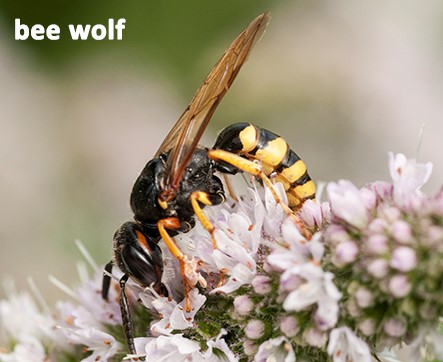
The larger species has been the bee wolf (Philanthus triangulum), which have spent all their time feeding on nectar and only making the occasional abortive attacks on bumblebees. I have yet to see one successfully attack a honey bee.

A smaller and commoner wasp species has been ornate-tailed digger wasps (Cerceris rybyensis) – again a species I am familiar locally digging nesting burrows in sandy soils, surprising to see it on clay. It provisions its nests with solitary bees, but again, I have not witnessed a successful attack.

There have been five species of butterfly visitng the mint. By far the most abundant species has been the gatekeeper. This summer it has been by far the most abundant butterfly in the garden. Passing visits have been made by both small and large whites (Pieris rapae and P. brassicae).
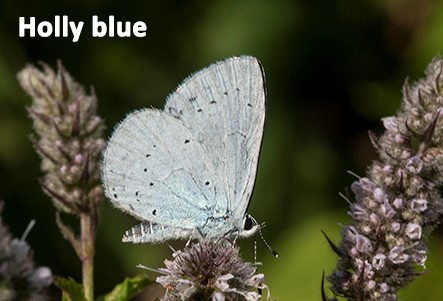
Holly blues (Celastina argiolus) have been common visitors to the mint.
Fleeting visits have been made by a peacock (Aglais io), a large skipper (Ochlodes sylvanus), a small copper (Lycaena phleas) and a silver-washed fritillary (Argynnis paphia); these visits have been too fleeting to record photographically.
There have been day-time visits by a couple of moth species. The most exciting being a yellow-legged clearwing moth (Synanthedon vespiformis).

This is a nationally scarce species, whose caterpillars feed between the bark and the wood of oak trees. Records of its occurrence are based on specimens attracted to pheromone traps, so seeing one feeding on the mint flowers was special.
The other common daytime flying moth was the mint moth (Pyrausta aurata), whose caterpillars could also be found feeding on the mint. Mint moths were also quite common visitors at night, but the commonest night-time moth visitors were Endotrichia flammealis, and the common and beautiful plume moths (Emmelina monodactyla and Amblyptillia acanthadacyla respectively). Other moths seen on the mint were Bryotropha terrella, a least carpet(Idaea rusticata), a buff footman (Eilema depressa), and a double-striped pug (Gymnoscelis rufifasciata).
There have been a great variety of fly visitors. The most numerous have been green-bottles (Lucilia) species, which were probably Lucilia sericata but there are many other very similar looking species.
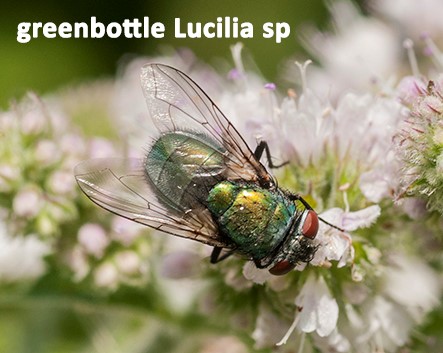
They are types of blowfly and are important forensically because they are part of a fixed sequence of blowfly species that lay their eggs on corpses and are used to estimate times of death. But as common visitors to a wide range of flowers and they also play a significant role in pollination.
Another visitor to the mint has been a muscid fly Graphomya maculata that is related to the common house fly. It was abundant for just a week after which no more appeared. One of the more curious flies that visited is one of the conopid thick-headed flies. It is a wasp mimic that I tentatively identify as Conops quadrifasciatus. These flies are more frequently seen visiting ragwort flowers. Their larvae are parasitoids of bees – in this case of the Bumblebees Bombus terrestris that were also common visitors to the mint. The female is repute to jump on its host as it flies by, and then prises open the scales of its abdomen and inserts an egg, inside the host’s abdomen. The egg hatches and the larva takes about ten days to develop inside the bee. As the larva approaches maturity it changes the behaviour of its host so that it digs into the ground and dies. The larva then pupates. Parasitized bees also tend to overnight outside the nest and maybe the reason why bumblebees can sometimes be found overnighting on tree trunks.

Another group of parasitic flies that has been common on the mint are the tachinids. The most conspicuous have been large very hairy species which are quite colourful. The commonest has been the Tachina fera which parasitizes moth caterpillars. No doubt this was one of the species that caused me immense grief when I was a small boy trying to breed caterpillars, when after weeks of careful nurturing my charges suddenly died and disgorged a mass of pupae.
A less common but equally large species was Nowickia ferox, which is more brightly coloured. It is another species that parasitises moth caterpillars. As a moth enthusiast, you may think I would resent these flies, but without them controlling moth abundances we would be plagued by caterpillars consuming our garden plants and gardeners would be using more insecticides to control their depredations.

An unexpected tachinid visitor to the mint has been Phasia hemiptera. Before this summer I had only seen it once before visiting blackthorn blossom in Compton Field in May. Its host species are shieldbugs – the green shieldbug and the red-legged forest bug. The latter species has been particularly abundant in the garden this year.

The fourth and most abundant tachinid species has been Eriothrix rufomaculata that parasitises the larvae of grass moths that are very abundant in mid to late summer.
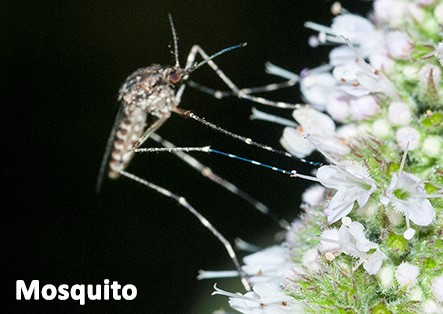
There have been some mosquitoes feeding on the mint flowers. It is the female mosquitoes that bite us. They need to feed on blood before they lay their eggs in a nearby puddle. The males feed on nectar and do not feed on blood; the picture shows a male that came to the mint.
The group of flies that are really important pollinators are the hoverflies (syrphids). A rich assortment visited the mint. The hoverfly that is most familiar to people is the marmalade hoverfly, which although it breeds in the UK, each year its populations are boosted by massive migrations from Europe. Surprisingly, I saw few on the mint. The most obvious types were three species of Volucella, whose larvae develop in wasp nests and tend to be most abundant in years following high abundances of wasps.

The commonest species was the great pied hoverfly (Volucella pellucens); a very striking species that is reported to be able to walk unopposed into wasp nests.

In contrast (Volucella bombylans) is a bumblebee mimic and has two colour forms depending on the dominant local bumblebee species. In our garden this was the buff-tailed bumblebee.

The third common Volucella species was V. inanis, which is a very effective wasp mimic, and I have a hard time persuading my grandchildren that they do not sting. It is only a little smaller than the scarcer hornet hoverfly V. zonaria that I saw once on the mint. V. inanis larvae occur in wasp nests and maybe in hornets’ nests as well. It is essentially a southern species but is spreading northwards in response to climate change.

The other hoverfly species that have been exploiting the mint include the bee mimic Eristalis arbustorum, which is one of the smaller species in the genus whose rat-tailed maggot larvae thrive in drains and temporary pools contaminated with dung.
Other very common hoverfly species were Chrysotoxum festivum, Myathropa florea , Syrrita pipiens and a Sphaecophoria species. All of which are important pollinators. The larvae of Syritta live in rotting organic matter, so having a good compost heap will encourage these useful little flies.

